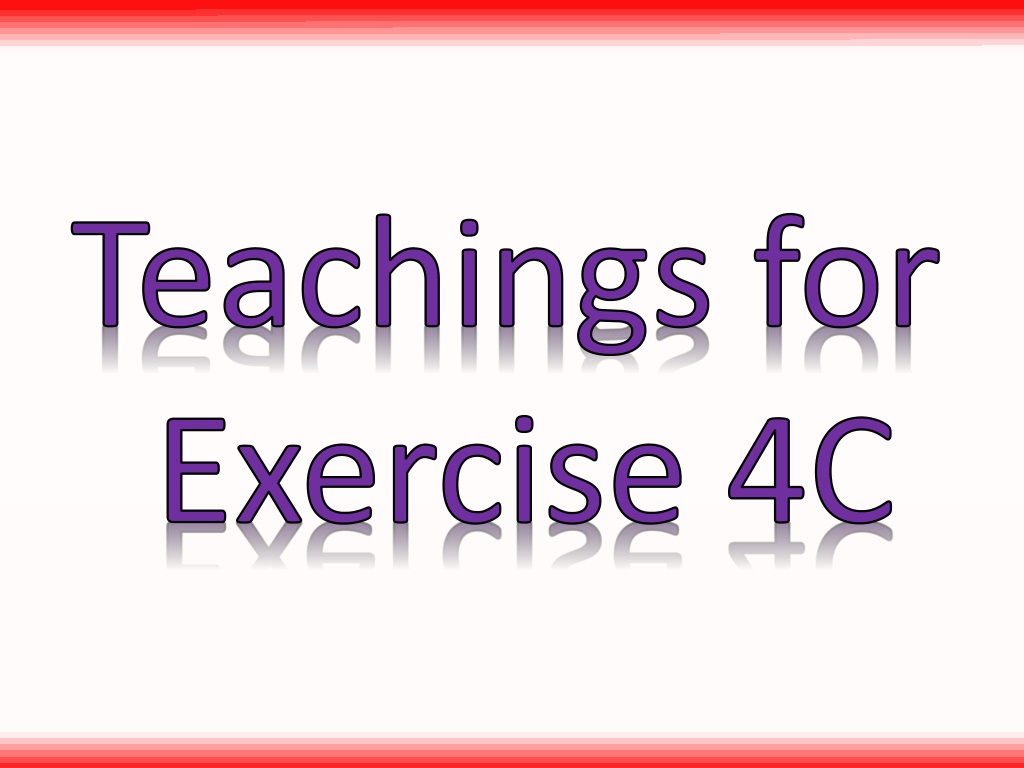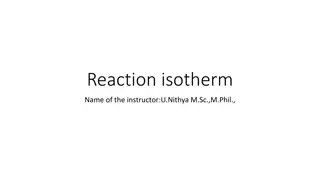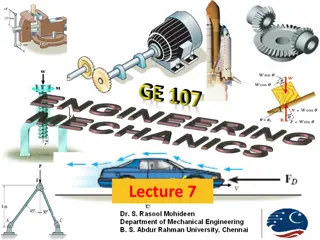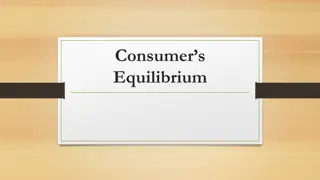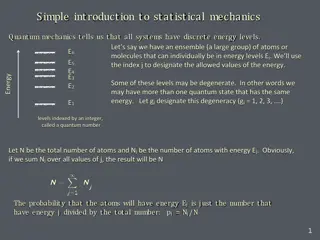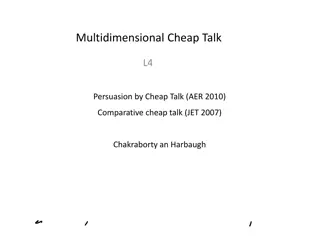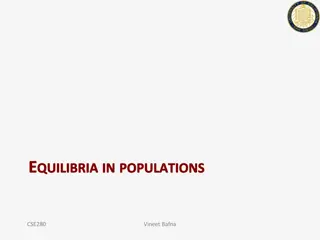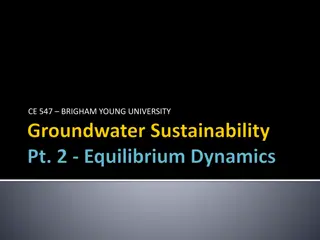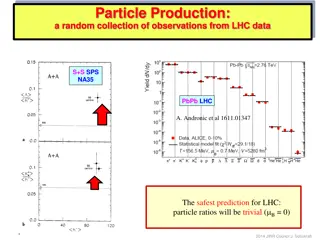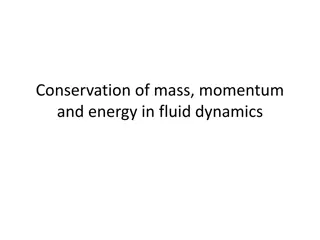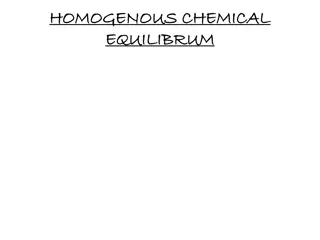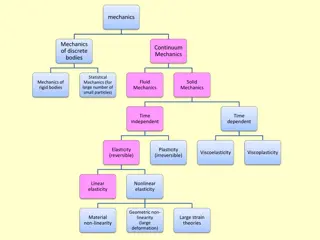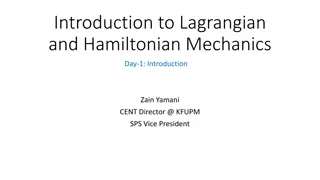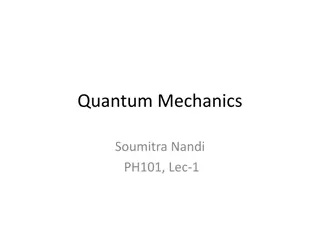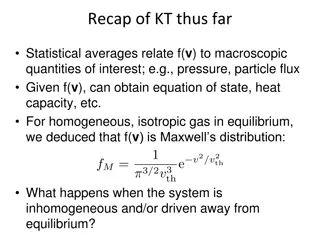Understanding Equilibrium in Mechanics
Learn how to solve problems involving bodies at rest using the principle of equilibrium. Moments and forces are balanced to ensure stability. Explore examples with detailed explanations and illustrations to grasp the concept effectively.
Download Presentation

Please find below an Image/Link to download the presentation.
The content on the website is provided AS IS for your information and personal use only. It may not be sold, licensed, or shared on other websites without obtaining consent from the author. Download presentation by click this link. If you encounter any issues during the download, it is possible that the publisher has removed the file from their server.
E N D
Presentation Transcript
Teachings for Exercise 4C
Moments 4m 4m You can solve problems about bodies resting in equilibrium by equating the clockwise and anticlockwise moments Y 10N (1) 10N (2) When a rigid body is in equilibrium, the resultant force in any direction is 0 Calculate the sum of the moments acting about the point Y Calculate each moment separately The moments about any point on the object will also sum to 0 (1) 10? 4? = 40?? ????????? (2) 10? 4? = 40?? ????????????? As the moments are equal in both directions, the rod will not turn and hence, is in equilibrium! As the rod is fixed at Y is will not be lifted up by the forces either! 4C
Moments 2m 6m You can solve problems about bodies resting in equilibrium by equating the clockwise and anticlockwise moments Z 1N (2) 3N (1) When a rigid body is in equilibrium, the resultant force in any direction is 0 Calculate the sum of the moments acting about the point Z Calculate each moment separately The moments about any point on the object will also sum to 0 (1) 3? 2? = 6?? ????????? (2) 1? 6? = 6?? ????????????? As the moments are equal in both directions, the rod will not turn and hence, is in equilibrium! 4C
Moments RA RC (1) You can solve problems about bodies resting in equilibrium by equating the clockwise and anticlockwise moments 2m 1m A B C 1.5m 0.5m When a rigid body is in equilibrium, the resultant force in any direction is 0 (2) Uniform rod = weight is in the centre 20N The moments about any point on the object will also sum to 0 As the rod is in equilibrium, the total normal reaction (spread across both supports) is equal to 20N (the total downward force) ??+ ??= 20 The diagram to the right shows a uniform rod of length 3m and weight 20N resting horizontally on supports at A and C, where AC = 2m. Take moments about C (you do not need to include RC as its distance is 0) (1) (2) 0.5 20 = 10?? ????????????? The clockwise and anticlockwise moments must be equal for equilibrium 2 ??= 2?? ????????? Calculate the magnitude of the normal reaction at both of the supports This makes sense as RC is closer to the centre of mass it is bearing more of the object s weight! 2??= 10 Divide by 2 ??= 5? Use the original equation to calculate RC ??= 15? 4C
Moments RC 40g 2RC 80g RD You can solve problems about bodies resting in equilibrium by equating the clockwise and anticlockwise moments 1.5m 1m C 1.5m 1m A B E D A uniform beam, AB, of mass 40kg and length 5m, rests horizontally on supports at C and D where AC = DB = 1m. As the reaction at D is bigger, the man must be closer to D than C Uniform beam = weight is in the centre 40g 80g When a man of mass 80kg stands on the beam at E, the magnitude of the reaction at D is double the reaction at C. The normal reactions must equal the total downward force 3??= 120? Divide by 3 ??= 40? By modelling the beam as a rod and the man as a particle, find the distance AE. RD is double this ??= 80? 4C
Moments (1) 40g (4) 80g You can solve problems about bodies resting in equilibrium by equating the clockwise and anticlockwise moments 1.5m 1m C 1.5m x 1m A B E D A uniform beam, AB, of mass 40kg and length 5m, rests horizontally on supports at C and D where AC = DB = 1m. (2) (3) 40g 80g Let us call the required distance x (from A to E) Take moments about A (we could do this around any point, but this will make the algebra easier) (1) 1 40? = 40? ?? ????????????? 2.5 40? = 100? ?? ????????? When a man of mass 80kg stands on the beam at E, the magnitude of the reaction at D is double the reaction at C. By modelling the beam as a rod and the man as a particle, find the distance AE. (2) (3) (4) ? 80? = 80?? ?? ????????? So the man is standing 3.25m from A! 4 80? = 320? ?? ????????????? Equilibrium so anticlockwise = clockwise 40? + 320? = 100? + 80?? Group terms Cancel g s Calculate 360? = 100? + 80?? 360 = 100 + 80? 3.25 = ? 4C
Moments (2) ? ? 1.5? You can solve problems about bodies resting in equilibrium by equating the clockwise and anticlockwise moments 3? (1) 1.5? 8? ? A uniform rod ?? is hinged at the point ?, and is held in equilibrium at an angle of 50 to the horizontal by a force of magnitude F acting perpendicular to the rod at ?. Given that the rod has a length of 3m and a mass of 8kg, find the value of ?. 50 ? 1.5???50 (1) 8? 1.5???50 = 12????50 ?? ????????? (2) You can choose to take moments about any point. ? 3 = 3? ?? ????????????? Since the system is in equilibrium, the clockwise and anticlockwise moments must be equal However, do not take moments about point ?, since this will eliminate ? (which we are trying to find) 3? = 12????50 Divide by 3 ? = 4????50 Let s take moments about point ? Calculate ? = 25.2 ? 4C
